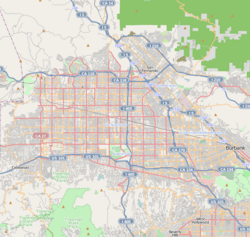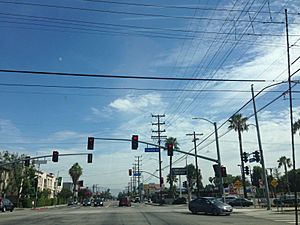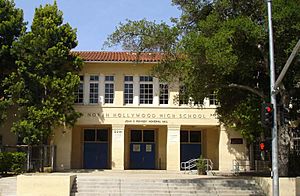Valley Village, Los Angeles facts for kids
Quick facts for kids
Valley Village
|
||
|---|---|---|
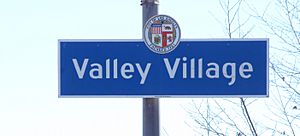
Valley Village signage located at the intersection of Burbank Boulevard and Laurel Canyon
|
||
|
||
| Country | United States | |
| State | California | |
| County | Los Angeles | |
| Area | ||
| • Total | 2.08 sq mi (5.39 km2) | |
| Population
(2010)
|
||
| • Total | 24,330 | |
| • Density | 11,690/sq mi (4,514/km2) | |
| Time zone | Pacific | |
| Zip Code |
91401, 91423, 91601, 91602, 91607
|
|
| Area code(s) | 747, 818 | |
Valley Village is a friendly neighborhood in the big city of Los Angeles, California. It's located inside the San Fernando Valley. It's known for its quiet streets and family-friendly feel.
Contents
History of Valley Village
How Valley Village Started
Valley Village has a cool history that goes back to the 1930s. Back then, people who worked at the nearby movie studios built their homes here. Even though the local post office used a "Valley Village" postmark, the area was officially part of North Hollywood.
The actor David Carradine lived here as a kid in 1939. He remembered Valley Village as a small, quiet town. It was surrounded by huge farms with orange, walnut, and peach trees. He said it felt like the very edge of Los Angeles at the time.
Becoming Its Own Neighborhood
For a long time, Valley Village was just a part of North Hollywood. But in 1985, about 300 homeowners met to talk about becoming a separate neighborhood. Their hard work paid off! By 1991, Los Angeles officially recognized Valley Village. The city even put up seven new blue signs to mark its borders.
Geography of Valley Village
Where Valley Village Is Located
Valley Village is in the San Fernando Valley. Its borders are set by the Valley Village Neighborhood Council.
- To the north, you'll find Burbank Boulevard.
- The Tujunga Wash is to the west.
- The Ventura Freeway (US 101) is to the south.
- And CA 170 is to the east.
Mapping Valley Village
Different maps show slightly different borders for Valley Village.
- Google Maps shows the same borders as the Neighborhood Council.
- The Los Angeles Times Mapping L.A. Project maps Valley Village a bit differently. For them, the borders are:
- Burbank Boulevard to the north.
- The Hollywood Freeway to the east.
- The Ventura Freeway to the south.
- And Coldwater Canyon Avenue to the west.
This neighborhood is about 2.09 square miles (5.39 square kilometers) in size. It's located north of Studio City, east of Sherman Oaks, and south and west of North Hollywood.

Valley Village Climate
Valley Village is in the San Fernando Valley, which means it has a special kind of weather. It's called a hot-summer Mediterranean climate. This means summers are long, hot, and dry. Winters are short, sunny, and usually warm.
- Summers: Average high temperatures are around 80s to low 90s °F (30–34 °C). It can get very hot, sometimes over 100 °F (38 °C). The hottest temperature ever recorded was 117 °F (47 °C) in September 2020.
- Winters: Average high temperatures are in the upper 60s to low 70s °F (20–23 °C). Nights can be chilly, in the 40s °F (4–7 °C). It doesn't rain much, but winter is when most of the rain happens. It rarely snows here. The coldest temperature ever recorded was 23 °F (–5 °C) in January 1979.
- Spring and Fall: These seasons are usually sunny and warm. Sometimes, strong, dry winds called Santa Ana winds blow through, which can make the air dry and increase the risk of wildfires. In late spring and early summer, it can sometimes be cloudy and foggy in the mornings. Locals call this "May Gray" or "June Gloom".
| Climate data for Valley Village, Los Angeles | |||||||||||||
|---|---|---|---|---|---|---|---|---|---|---|---|---|---|
| Month | Jan | Feb | Mar | Apr | May | Jun | Jul | Aug | Sep | Oct | Nov | Dec | Year |
| Record high °F (°C) | 92 (33) |
92 (33) |
98 (37) |
103 (39) |
105 (41) |
114 (46) |
115 (46) |
112 (44) |
117 (47) |
106 (41) |
97 (36) |
93 (34) |
117 (47) |
| Mean daily maximum °F (°C) | 67.4 (19.7) |
68.1 (20.1) |
71.0 (21.7) |
74.5 (23.6) |
78.7 (25.9) |
84.0 (28.9) |
90.3 (32.4) |
91.9 (33.3) |
88.7 (31.5) |
81.2 (27.3) |
73.6 (23.1) |
67.1 (19.5) |
78.0 (25.6) |
| Mean daily minimum °F (°C) | 42.1 (5.6) |
43.4 (6.3) |
45.6 (7.6) |
48.6 (9.2) |
53.3 (11.8) |
57.0 (13.9) |
61.0 (16.1) |
61.2 (16.2) |
59.1 (15.1) |
52.8 (11.6) |
45.6 (7.6) |
41.2 (5.1) |
50.9 (10.5) |
| Record low °F (°C) | 23 (−5) |
26 (−3) |
28 (−2) |
30 (−1) |
32 (0) |
36 (2) |
40 (4) |
41 (5) |
39 (4) |
31 (−1) |
28 (−2) |
26 (−3) |
23 (−5) |
| Average precipitation inches (mm) | 3.94 (100) |
4.32 (110) |
3.51 (89) |
0.84 (21) |
0.27 (6.9) |
0.06 (1.5) |
0.01 (0.25) |
0.17 (4.3) |
0.25 (6.4) |
0.50 (13) |
1.19 (30) |
2.05 (52) |
17.12 (435) |
Homes in Valley Village
In 1994, the Los Angeles Times called Valley Village an "area of upscale residences." Many homes here are single-story Spanish or ranch-style houses. They often sit on nice-sized lots. There are also many condos and apartment buildings along the main streets.
Population of Valley Village
In 2000, about 24,190 people lived in Valley Village. This means there were about 11,600 people per square mile, which is about average for Los Angeles. By 2008, the population grew to an estimated 25,665.
Valley Village has a mix of different cultures. Most residents are white, but there are also many Latino, Black, and Asian people living here. The average age of people in Valley Village is 36, which is a bit older than the average for the whole city. There is also a large Jewish community in the area.
The average household income in 2008 was about $55,470, which was typical for the city. The average household size was two people, which is a bit smaller than the city average.
Education in Valley Village
Valley Village has several schools for students of all ages.
High Schools:
- North Hollywood High School, located at 5231 Colfax Avenue. It's part of the LAUSD (Los Angeles Unified School District).
- Valley Torah High School, a private school at 12517 Chandler Boulevard.
Continuation School:
- Amelia Earhart, located at 5355 Colfax Avenue, also part of LAUSD.
Elementary Schools:
- Burbank Boulevard Elementary, at 12215 Albers Street, LAUSD.
- Colfax Elementary, a charter school at 11724 Addison Street, LAUSD.
Parks and Recreation
Valley Village offers great places for outdoor fun and relaxation.
- Valley Village Park: You can find this park at 5000 Westpark Drive. It has a children's play area, picnic tables, restrooms, and walking paths. It's a perfect spot for families to enjoy.
- Tujunga Wash Greenway: This is a natural area that follows the Tujunga Wash. It offers a green space for walking and enjoying nature.
Marilyn Monroe's House
A house at 5258 Hermitage Avenue was once home to the famous actress Marilyn Monroe. She lived there in 1944–45 when she was 17 years old, using her married name, Norma Jean Dougherty. At that time, her husband was in the Navy, and she worked inspecting parachutes at a nearby factory.
In June 2015, this house was torn down by a property developer to build new apartments. This happened even though some people wanted it to be saved as a historic landmark. City officials said it was unlikely to become a landmark because Marilyn Monroe only lived there for one year and it was before she became famous.
Later in 2015, a group called Save Valley Village sued the city over the house's destruction. They argued that the city should have done an environmental review before allowing the building to be torn down.
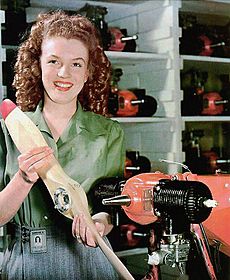
Famous People from Valley Village
Valley Village has been home to some notable people:
- Ryan Turell (born 1999), a basketball player who plays in the Israeli Basketball Premier League.
- Richard Rossi (born 1963), a filmmaker, novelist, and musician.
Twin Town
Valley Village has a special connection with a town in France! It is twinned with Saint-Nom-la-Bretèche, France. This means they have a friendly relationship and often share cultural exchanges.
|
See also
 In Spanish: Valley Village (Los Ángeles) para niños
In Spanish: Valley Village (Los Ángeles) para niños



